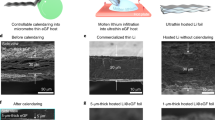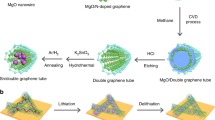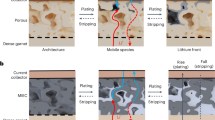Abstract
Developing high-capacity anodes is a must to improve the energy density of lithium batteries for electric vehicle applications. Alloy anodes are one promising option, but without pre-stored lithium, the overall energy density is limited by the low-capacity lithium metal oxide cathodes. Recently, lithium metal has been revived as a high-capacity anode, but faces several challenges owing to its high reactivity and uncontrolled dendrite growth. Here, we show a series of Li-containing foils inheriting the desirable properties of alloy anodes and pure metal anodes. They consist of densely packed LixM (M = Si, Sn, or Al) nanoparticles encapsulated by large graphene sheets. With the protection of graphene sheets, the large and freestanding LixM/graphene foils are stable in different air conditions. With fully expanded LixSi confined in the highly conductive and chemically stable graphene matrix, this LixSi/graphene foil maintains a stable structure and cyclability in half cells (400 cycles with 98% capacity retention). This foil is also paired with high-capacity Li-free V2O5 and sulfur cathodes to achieve stable full-cell cycling.
This is a preview of subscription content, access via your institution
Access options
Access Nature and 54 other Nature Portfolio journals
Get Nature+, our best-value online-access subscription
$29.99 / 30 days
cancel any time
Subscribe to this journal
Receive 12 print issues and online access
$259.00 per year
only $21.58 per issue
Buy this article
- Purchase on Springer Link
- Instant access to full article PDF
Prices may be subject to local taxes which are calculated during checkout





Similar content being viewed by others
References
Chu, S. & Majumdar, A. Opportunities and challenges for a sustainable energy future. Nature 488, 294–303 (2012).
Armand, M. & Tarascon, J. M. Building better batteries. Nature 451, 652–657 (2008).
Yoshio, M., Wang, H. Y., Fukuda, K., Hara, Y. & Adachi, Y. Effect of carbon coating on electrochemical performance of treated natural graphite as lithium-ion battery anode material. J. Electrochem. Soc. 147, 1245–1250 (2000).
Obrovac, M. N. & Chevrier, V. L. Alloy negative electrodes for Li-ion batteries. Chem. Rev. 114, 11444–11502 (2014).
Shi, F. F. et al. Failure mechanisms of single-crystal silicon electrodes in lithium-ion batteries. Nat. Commun. 7, 11886 (2016).
Chan, C. K. et al. High-performance lithium battery anodes using silicon nanowires. Nat. Nanotech. 3, 31–35 (2008).
Son, I. H. et al. Silicon carbide-free graphene growth on silicon for lithium-ion battery with high volumetric energy density. Nat. Commun. 6, 7393 (2015).
Liu, N. et al. A pomegranate-inspired nanoscale design for large-volume-change lithium battery anodes. Nat. Nanotech. 9, 187–192 (2014).
Wang, J. Z., Zhong, C., Chou, S. L. & Liu, H. K. Flexible free-standing graphene-silicon composite film for lithium-ion batteries. Electrochem Commun. 12, 1467–1470 (2010).
Zhu, Y. H. et al. Directing silicon-graphene self-assembly as a core/shell anode for high-performance lithium-ion batteries. Langmuir 29, 744–749 (2013).
Cui, L. F., Hu, L. B., Choi, J. W. & Cui, Y. Light-weight free-standing carbon nanotube-silicon films for anodes of lithium ion batteries. ACS Nano 4, 3671–3678 (2010).
Wu, X. L. et al. Carbon-nanotube-decorated nano-LiFePO4@C cathode material with superior high-rate and low-temperature performances for lithium-ion batteries. Adv. Energy Mater. 3, 1155–1160 (2013).
Wang, L. et al. Crystal orientation tuning of LiFePO4 nanoplates for high rate lithium battery cathode materials. Nano Lett. 12, 5632–5636 (2012).
Ji, X. L., Lee, K. T. & Nazar, L. F. A highly ordered nanostructured carbon-sulfur cathode for lithium-sulfur batteries. Nat. Mater. 8, 500–506 (2009).
Liu, Y. Y. et al. V2O5 nano-electrodes with high power and energy densities for thin film Li-ion batteries. Adv. Energy Mater. 1, 194–202 (2011).
Jin, S. et al. Covalently connected carbon nanostructures for current collectors in both the cathode and anode of Li–S batteries. Adv. Mater. 28, 9094–9102 (2016).
Shen, C. F. et al. Silicon(lithiated)-sulfur full cells with porous silicon anode shielded by Nafion against polysulfides to achieve high capacity and energy density. Nano Energy 19, 68–77 (2016).
Xu, W. et al. Lithium metal anodes for rechargeable batteries. Eng. Environ. Sci. 7, 513–537 (2014).
Kim, H. et al. Metallic anodes for next generation secondary batteries. Chem. Soc. Rev. 42, 9011–9034 (2013).
Aurbach, D., Zinigrad, E., Cohen, Y. & Teller, H. A short review of failure mechanisms of lithium metal and lithiated graphite anodes in liquid electrolyte solutions. Solid State Ion. 148, 405–416 (2002).
Chandrashekar, S. et al. 7Li MRI of Li batteries reveals location of microstructural lithium. Nat. Mater. 11, 311–315 (2012).
Xu, K. Nonaqueous liquid electrolytes for lithium-based rechargeable batteries. Chem. Rev. 104, 4303–4417 (2004).
Liang, Z. et al. Composite lithium metal anode by melt infusion of lithium into a 3D conducting scaffold with lithiophilic coating. Proc. Natl Acad. Sci. USA 113, 2862–2867 (2016).
Lin, D. C. et al. Layered reduced graphene oxide with nanoscale interlayer gaps as a stable host for lithium metal anodes. Nat. Nanotech. 11, 626–632 (2016).
Mogi, R. et al. Effects of some organic additives on lithium deposition in propylene carbonate. J. Electrochem. Soc. 149, 1578–1583 (2002).
Ding, F. et al. Dendrite-free lithium deposition via self-healing electrostatic shield mechanism. J. Am. Chem. Soc. 135, 4450–4456 (2013).
Yan, K. et al. Ultrathin two-dimensional atomic crystals as stable interfacial layer for improvement of lithium metal anode. Nano Lett. 14, 6016–6022 (2014).
Kazyak, E., Wood, K. N. & Dasgupta, N. P. Improved cycle life and stability of lithium metal anodes through ultrathin atomic layer deposition surface treatments. Chem. Mater. 27, 6457–6462 (2015).
Yan, K. et al. Selective deposition and stable encapsulation of lithium through heterogeneous seeded growth. Nat. Energy 1, 16010 (2016).
Kozen, A. C. et al. Next-generation lithium metal anode engineering via atomic layer deposition. ACS Nano 9, 5884–5892 (2015).
Xiang, B., Wang, L., Liu, G. & Minor, A. M. Electromechanical probing of Li/Li2CO3 core/shell particles in a TEM. J. Electrochem. Soc. 160, 415–419 (2013).
Wang, Z. H. et al. Application of stabilized lithium metal powder (SLMP (R)) in graphite anode—a high efficient prelithiation method for lithium-ion batteries. J. Power Sources 260, 57–61 (2014).
Qian, J. F. et al. High rate and stable cycling of lithium metal anode. Nat. Commun. 6, 6362 (2015).
Stankovich, S. et al. Synthesis of graphene-based nanosheets via chemical reduction of exfoliated graphite oxide. Carbon 45, 1558–1565 (2007).
Zang, J. F. et al. Multifunctionality and control of the crumpling and unfolding of large-area graphene. Nat. Mater. 12, 321–325 (2013).
Bunch, J. S. et al. Impermeable atomic membranes from graphene sheets. Nano Lett. 8, 2458–2462 (2008).
Zhao, J. et al. Dry-air-stable lithium silicide–lithium oxide core–shell nanoparticles as high-capacity prelithiation reagents. Nat. Commun. 5, 5088 (2014).
Zhou, G. M. et al. A graphene-pure-sulfur sandwich structure for ultrafast, long-life lithium-sulfur batteries. Adv. Mater. 26, 625–631 (2014).
Li, X. S. et al. Large-area synthesis of high-quality and uniform graphene films on copper foils. Science 324, 1312–1314 (2009).
Cambaz, Z. G., Yushin, G., Osswald, S., Mochalin, V. & Goyotsi, Y. Noncatalytic synthesis of carbon nanotubes, graphene and graphite on SiC. Carbon 46, 841–849 (2008).
Aurbach, D., Weissman, I., Schechter, A. & Cohen, H. X-ray photoelectron spectroscopy studies of lithium surfaces prepared in several important electrolyte solutions. A comparison with previous studies by Fourier transform infrared spectroscopy. Langmuir 12, 3991–4007 (1996).
Li, W. et al. The synergetic effect of lithium polysulfide and lithium nitrate to prevent lithium dendrite growth. Nat. Commun. 6, 7436 (2015).
Seh, Z. W. et al. Sulfur–TiO2 yolk–shell nanoarchitecture with internal void space for long-cycle lithium–sulfur batteries. Nat. Commun. 4, 1331 (2013).
Acknowledgements
Y.C. acknowledges the support from the Assistant Secretary for Energy Efficiency and Renewable Energy, Office of Vehicle Technologies, Battery Materials Research Program of the US Department of Energy. Y.L. acknowledges the National Science Foundation Graduate Fellowship Program.
Author information
Authors and Affiliations
Contributions
J.Z., G.Z. and Y.C. conceived the concept. J.Z. and G.Z. carried out the synthesis and performed materials characterization and electrochemical measurements. J.X., Y.J., L.L., Y.L., P.-C.H. and J.W assisted in the synthesis and characterization of electrode materials. K.L. conducted stress–strain tests. K.Y. and H.-M.C. provided important experimental insights. J.Z., G.Z., K.Y., Y.L., H.-M.C. and Y.C. co-wrote the paper. All authors discussed the results and commented on the manuscript.
Corresponding author
Ethics declarations
Competing interests
The authors declare no competing financial interests.
Supplementary information
Supplementary information
Supplementary Information (PDF 2041 kb)
Supplementary Movie
Supplementary Movie (MOV 18068 kb)
Rights and permissions
About this article
Cite this article
Zhao, J., Zhou, G., Yan, K. et al. Air-stable and freestanding lithium alloy/graphene foil as an alternative to lithium metal anodes. Nature Nanotech 12, 993–999 (2017). https://doi.org/10.1038/nnano.2017.129
Received:
Accepted:
Published:
Issue Date:
DOI: https://doi.org/10.1038/nnano.2017.129
This article is cited by
-
Dynamically lithium-compensated polymer artificial SEI to assist highly stable lithium-rich manganese-based anode-free lithium metal batteries
Rare Metals (2024)
-
Li–air batteries: air stability of lithium metal anodes
Science China Chemistry (2024)
-
Towards practical lithium metal batteries with composite scaffolded lithium metal: an overview
Advanced Composites and Hybrid Materials (2023)
-
2D Materials Boost Advanced Zn Anodes: Principles, Advances, and Challenges
Nano-Micro Letters (2023)
-
Fundamentals, preparation, and mechanism understanding of Li/Na/Mg-Sn alloy anodes for liquid and solid-state lithium batteries and beyond
Nano Research (2023)



